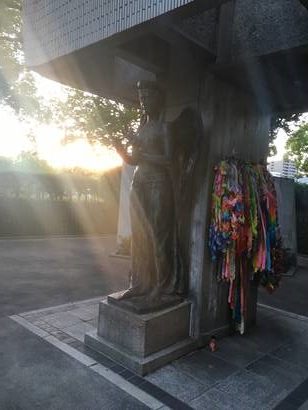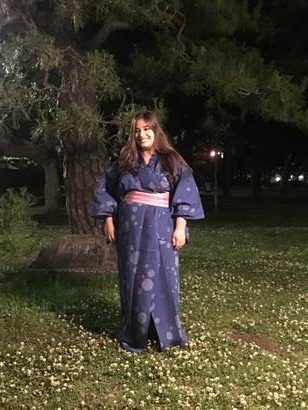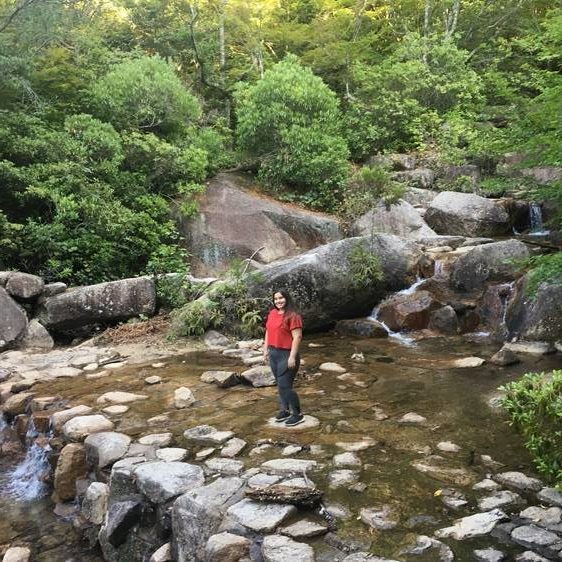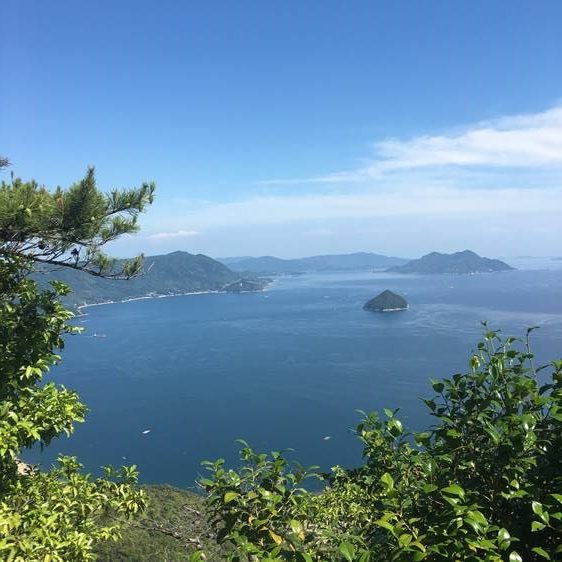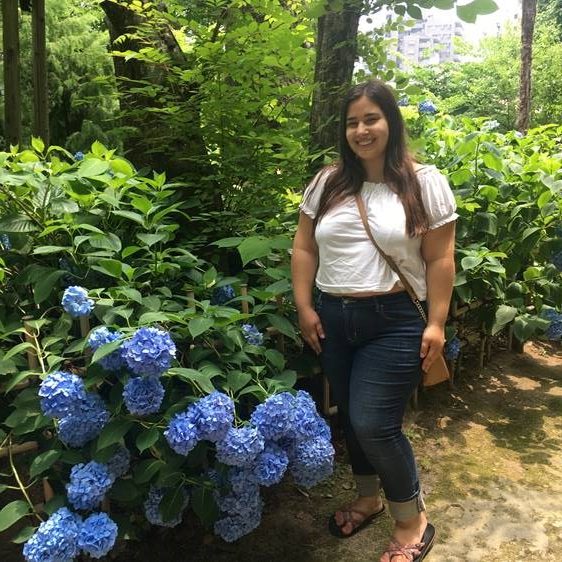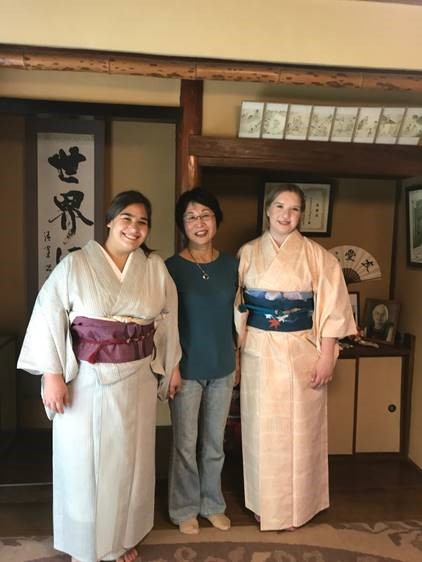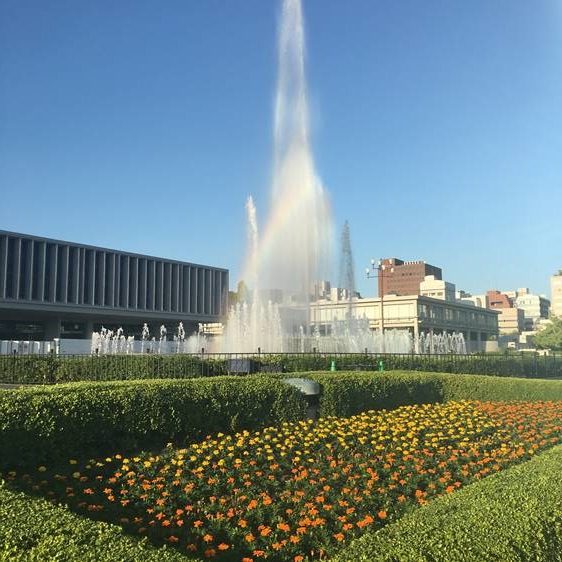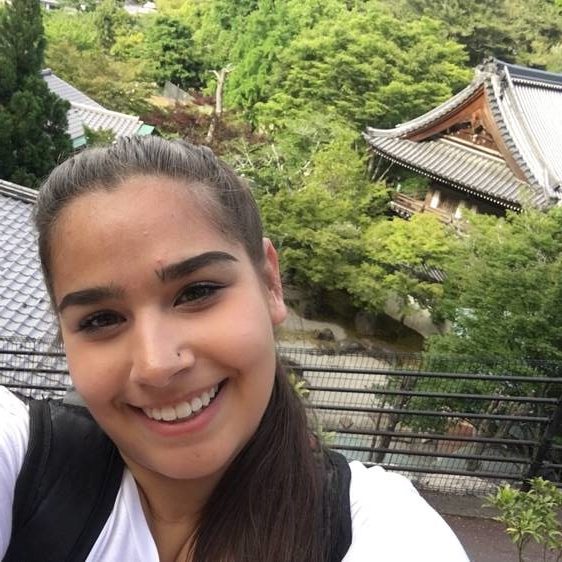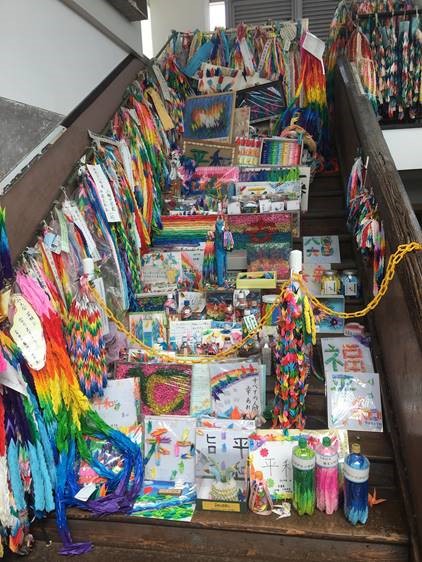WFC News
Yu-ai Friendship
Newsletter of the World Friendship Center, NPO
Experiencing Hiroshima through the World Friendship Center
Yovana Milosevic
(Translated by Sumiko Kanetsuna)
Briefly living in Hiroshima, Japan and staying at the World Friendship Center is easily the biggest blessing in my life. I encountered an entirely different culture by living in it for a month and a half, and there were surprises waiting for me at every corner. I was able to participate in daily discussions involving peace, compassion, kindness, and debates on current world issues. I attended numerous lectures on not only Hiroshima’s history specifically, but also about how it has been represented in the media over time, what the current nuclear situation is, which countries do and do not possess nuclear warheads, current problems in Israel-Palestine, and the influence of Fukushima in modern politics.
In addition to these riveting and relevant lectures, I heard several accounts of what happened the day of August 6th, 1945. I was able to have conversations with people who survived that day, and all the days after. There was a palpable sense of resilience and love radiating throughout WFC, and now that I’ve returned, that is one of my strongest memories.
The hibakusha faced the world’s most hideous atrocity, yet they live their lives focusing each moment on peace. They have devoted their lives to spreading peace, and this is not a sentiment anyone should take lightly. It is difficult to find positivity and hope for the future during such turbulent political times, yet the people at WFC make this their purpose. I was constantly inspired at WFC, and my hope for the future is that we all (myself included), take on the responsibility of actively advocating for peace. I appreciate the World Friendship Center, their English classes, the lovely members, and all of the profound experiences I had this past summer.
Copyright © NPO World Friendship Center 2019 All Rights Reserved
Yu-ai Friendship
Newsletter of the World Friendship Center, NPO
WFC Peace Seminar Activity Report
Observation tour to Tottori Yonago Solar Park and
Pumped-Storage Hydroelectric Power Station
by Asaka Watanabe
(Translated by Mikiko Shimizu)
Six members of the WFC Peace Seminar including the lecturer, Syoji Kihara, went on a trip October 22nd and 23rd.
It was a tour to learn from a variety of places, such as –
- the circumstances of the Shimane nuclear power plant
- an observation tour of the Matanogawa Pumped-Storage Hydroelectric Station between Tottori and Okayama
- Tottori Nature and Environment Center which is a base of Tottori
- Soft Bank Tottori Yonago Solar Park
- Yonago Waterfowls Park, among others.
We listened to a lecture by Hitoshi Doko at his own tea house. The tea house “Yodoemon” uses an unoccupied house in front of his home in Yodoe-cho. We enjoyed delicious cakes and coffee there. Hitoshi is a councilman from Yonago who pursues the goal of denuclearization. His talk started with a quiz asking us where the Shimane nuclear power plant was located. Then, he told us about an evacuation route to be used if a very bad accident occurs. He indicated a problem for the entire Japanese island, because radioactivity would move downwind according to the direction of the wind – usually a wind from the west.
Tottori Nature and Environment Center is managed as a core institution for environmental education. The highlight is the Soft Bank Tottori Yonago Solar Park, which spreads out next to the center and is the largest solar power facility in Japan. The amount of electrical production is equivalent to that consumed in a year by approximately 12,000 ordinary households. Tottori Next-Generation Energy Park consists of over fifty facilities producing power from solar energy panels or hydropower or wind power. An eco-tour around the facility and other local sites was also provided.
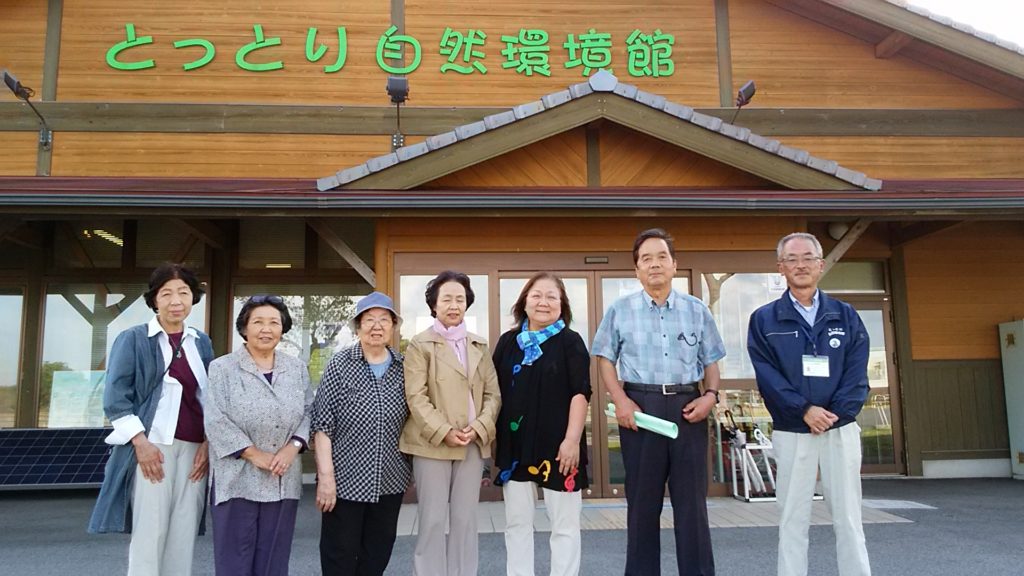
The Nature and Environment Center keeps a family of three goats to eat weeds. To help feed them, we picked leaves of the Kuzu vine (Pueraria lobate) on the river bank to give to the animals. As a side note, the Center does not use any herbicides, and the goats are actually more popular with the children than they are useful at eating weeds.
Near Nakaumi is Yonago Waterfowls Park, one of the best wild fowl habitats in western Japan. Here you can find nearly 42% of all the types of wild fowls found in the nation. These amount to about 120 kinds of wild fowl and more than 10,000 total birds. Yonago Waterfowls Park has been operating as an institution, with the assistance of concerned citizens, who together help protect and preserve nature. We enjoyed observing water fowl through a telescope in the observation hall while listening to a volunteer instructor’s explanation. A wintering place for a whistling swan group is located at the southern border of Japan. Unfortunately, we couldn’t see the graceful fowls in their group as they had swum out for food.
The next morning, we visited Matanogawa pumped-storage hydroelectric power station, which was the main purpose for this trip. Matanogawa dam produces 1,200,000kw by using the 500m difference in the height of the upper and lower dams. The upper reservoir (Doyoh dam in Shinjho-mura, Okayama) and the lower reservoir (Matanogawa dam koufu-cho in Tottori) are large-scale facilities connecting both prefectures – Okayama and Tottori. There is an underground power house located beneath the lower reservoir, where the electric power is produced in daytime. Water is pumped up at night time by reversing the rotation direction of a reversible pump-turbine and generator motor.
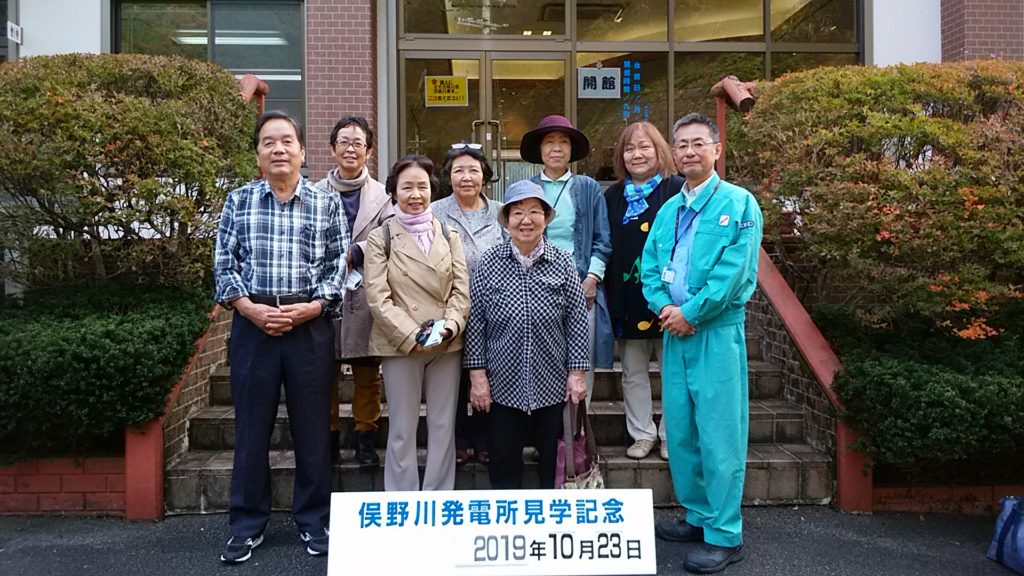
The pumped-storage hydroelectric power’s role is to make up for the difference in demand because it changes depending on the season, time, and day. It also changes in dry weather by using solar energy generation. Quite simply, the plant plays a prominent role in charging or discharging a large rechargeable battery.
During the night when the usage charge is less, water is pumped up from the lower reservoir using the electric power from the thermal power stations or the nuclear power stations. The electricity in the daytime, when it is in great demand, is produced by dropping water into the lower reservoir from the upper reservoir and adjusted to the demands of consumer power. It is then sent as electricity to homes or factories. It takes 7 hours to create electricity by dropping water from the upper reservoir to the lower reservoir and 10 hours to pump it up from the lower reservoir to the upper reservoir. Though it might seem to be a loss of 3 hours, this gap in time is necessary to maintain a stable supply of electricity.
Chugoku Electric Power Company has Matanogawa pumped-storage hydroelectric power station and two other pumped-storage hydroelectric power stations – Shinnariwagawa in Okayama (with a power capacity of 303,000kw) and Nabara in Hiroshima (with a power capacity of 620,000kw.) I thought that the mechanism to balance production of electric power by using different sources was very interesting.
The leaves around the pumped-storage hydroelectric power station have already begun to turn to fall colors. There seemed to be a chance to meet monkeys, deer and wild boar, maybe even a bear……unfortunately, we couldn’t see the underground power house this time because of ongoing construction.
We saw a catch-phrase of “Riches of Abundant Nature, Tottori” written in a pamphlet. I felt that the effort toward nature and the environment which Tottori is undertaking – repeating trial and error time after time – will become the theme of living and be passed on to the next generation. This was our educational trip to be applied in a variety of ways in our future activities.
It was beautiful weather! We spent time in a relaxed atmosphere sharing lunch, which we got at the road station, “Takano”, and took in a scenic overlook of Lake Shinjiko. We stayed in a hotel called “Unabara Soh” one night and enjoyed a hot spring, delicious meal, and conversation. It recharged our energy!
When we came back, we drove in Bihoku Hillside National Government Park; unfortunately, we couldn’t see the field of cosmos flowers – it had closed a day before. After eating lunch at a restaurant in the park, we stopped by Miyoshi boutique winery to buy some souvenirs and left for home.
Dear Syoji Kihara,
Thank you so much for planning, preparing, and driving on the trip, with plenty of attention to us.
We offer our heartfelt thanks.
In writing this report, I used many phrases and thoughts of the participants’ emails.
Copyright © NPO World Friendship Center 2019 All Rights Reserved
Yu-ai Friendship
Newsletter of the World Friendship Center, NPO
One Friend at a Time
Barbara Shenk
In August, 2017, Hiroshima became our home, to a much greater degree than we could have imagined. Many wonderful people involved in the World Friendship Center and beyond quickly befriended us. The more we learned of Barbara Reynolds and the mission of WFC, the more it became our mission. Sharing this mission with the 800 or so guests we hosted, over 1600 or so breakfasts we served, confirmed to us that peace is fostered “one friend at a time.” As we walked and bicycled in and around the beautiful city, we discovered almost magical places for relaxation and refreshment. We already miss all these aspects of our two busy years at WFC.
We miss the English classes where we read and discussed literature and histories together. In these classes we learned so much about the daily lives and interests of our students and about special customs and places in Hiroshima and Japan. And we laughed a lot.
We miss the breakfasts with our guests where we had great discussions about war, peace, cultures, politics, and personal experiences. Having guests from different parts of the world connect over breakfast was particularly satisfying. Sometimes they would make arrangements to meet each other again.
We miss the warm friendships of the WFC board members and many others who came to support us and participate in the mission of WFC in whatever way they could. This included helping with cleaning, bringing food, translating, editing, carrying away and disposing of unneeded items, improving the WFC website, taking guests or interns to the doctor, painting, sorting through books and documents, and moving furniture.
We miss the beauty of Hiroshima, from the rivers which were our daily companions, to Miyajima, the Inland Sea, the mountains, and perhaps as much as anything, the Mitaki temple complex and hills. We also miss the oysters, okonomiyaki, and all the other wonderful foods of Hiroshima.
Perhaps the most rewarding aspect of our work in Hiroshima was witnessing the interactions between our guests and the hibakusha who came to share their stories. Our guests were moved beyond words and often told us that this experience changed their lives forever. It is impossible to calculate the effects of these guests retelling the stories back in their home countries.
From the bottom of my heart I wish to thank all of you who enriched our lives immeasurably over our two years in Hiroshima. We will never forget you or the mission we share.
Copyright © NPO World Friendship Center 2019 All Rights Reserved
Yu-ai Friendship
Newsletter of the World Friendship Center, NPO
Reflections on Hiroshima
Dannie Otto
It is difficult to write about my experiences in Hiroshima, because when I think about the past two years, my mind is flooded with memories. We met many wonderful people. First of all, the Hiroshima people who are involved with WFC and contribute so much time and energy to the work of the center. In addition, there were the many interesting guests who came from many countries to learn about the effects of the atomic bomb on Hiroshima. At times it seemed like we lived in two worlds. On some days, we would spend time with our international guests, serving them breakfast and then telling them the story of Barbara Reynolds and her work for peace and nuclear disarmament. Immediately after telling the Reynolds story, I would go to meet with local members of WFC in an English class where we would also reflect on the effect of the bomb on Hiroshima. I wish we could have brought these two groups of people together.
We enjoyed all of our international guests, but there were several who stand out in my memory. In February of our first year, a time when we were not very busy with guests, we received a request from a woman for a party of two, male and female. The reservation was on short notice but she was persistent that we could assure her that they could hear the story of an A-bomb survivor. When they arrived, we had time for tea and conversation together. After introductions, the woman asked if we ever have people in the military visit us. I couldn’t think of any but assured them that military people would be welcome. She then urged her male friend to tell us what he did. Eventually he told us that he was active duty in the U.S. Air Force and served in the Strategic Air Command where his job was to develop the programming to guide American nuclear armed bomber jets to their targets. His job was to develop a detailed checklist to guide bomber pilots from their base in Louisiana to the potential targets. His friend then interjected that they had come to Hiroshima and WFC because she wanted him to understand what would happen if there were another nuclear war.
The following day our two guests heard a survivor story, toured the Peace Memorial Park with a WFC guide and then visited the museum. In the evening he and I talked late into the night about war, the threat of war and the nature of peace. The next morning, they left. We never learned his name. He indicated that his superiors in the Air Force would not be happy if they knew of his visit. We never heard from them again. I often wonder if his visit to Hiroshima and WFC changed his views on his job.
Barbara Reynolds set the mission of WFC as “Fostering Peace, One friend at a time”. We believe that this is an important mission and the example of our encounter with a member of the Air Force is one example of how we can engage people on a personal level with serious conversations. I am very grateful to WFC for giving me the opportunity to engage in peacemaking in this very personal way.
Copyright © NPO World Friendship Center 2019 All Rights Reserved
Yu-ai Friendship
Newsletter of the World Friendship Center, NPO
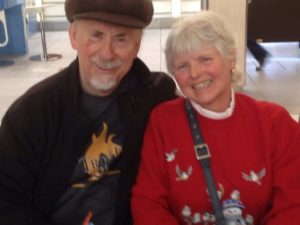 Greeting from Roger and Kathy Edmark, new co-Directors of the World Friendship Center. We have now been in Hiroshima for over a month and are enjoying our time at WFC. We would like to thank all of the staff and volunteers at WFC for the warm welcome we have received.
Greeting from Roger and Kathy Edmark, new co-Directors of the World Friendship Center. We have now been in Hiroshima for over a month and are enjoying our time at WFC. We would like to thank all of the staff and volunteers at WFC for the warm welcome we have received.
Roger Edmark
I was born in North Dakota, in the USA. Before I was one year old, my parents moved to Seattle. They packed up my older sister and me in the car and drove to Seattle to look for milder weather and better employment opportunities. Within one week, my father was employed by the Boeing Company. Twenty-two years later, I too would be employed by Boeing.
All of my schooling, grade school through high school, was in Seattle. My favorite activity as I grew up was playing baseball which I did through High School. I have always loved sports (baseball, softball, basketball, golf and others) either participating, coaching, or watching it. After high school I worked for Norse Home, a retirement home in Seattle. I was a pot and pan washer. I continued to work there after enrolling at the University of Washington, also in Seattle. I first studied Architecture, but eventually received a BA in Philosophy. After graduating, I worked for the Boeing Company for 43-years, mostly in Aerodynamic Engineering. My job involved international travel, and Tokyo Japan was a frequent destination.
When I was in my 50’s, I was told by the doctor that I had a heart murmur. The murmur was caused by a congenital heart defect of my aortic valve. I would need to have it fixed if I wanted to live a normal active life. So, at 57 years of age I had an operation to replace the faulty valve with a new artificial one. Today, my heart works like a clock – it literally beats one beat per second. My grandchildren like to put their heads on my chest and hear the clock (heart valve) click away. The whole process was a reminder that there are no guarantees as to how long we live, so we need to cherish each day as it comes.
Kathy Edmark
I was born in Twin Falls Idaho. My parents accepted a call from the Christian church to go as missionaries to Miyako Jima when I was 4 years old. For the next 11 years I lived in Miyako, Kobe Japan and Okinawa with 1 year in Seattle. When I was 15 years old, I returned to Seattle where I completed my last two years of high school. I too got a job at Norse Home in my last year of high school, which is where I met Roger. Three years later, we were married.
My first job after getting married was in the home, which took all of my time until all four of our children were in school. I then answered a call to serve in our church for a couple of years as Christian education director. After that I became a para-educator in the school district our children were attending. I worked for the school district for 25 years.
One of my skills has been sewing. My grandmother started me sewing at a young age. The rest I learned from directions on patterns. I made and sold Barbie doll clothes as a first “job”. I made some of my own clothes as a teenager. I made my own wedding dress! One time I made outfits for all 4 of my children including a 3-piece suit for my son for a family picture. I did a lot of sewing for my daughter Aimee’s ballet school, including short tutus. I made my first daughter’s wedding dress and her attendants’ dresses. My second daughter would only let me alter her purchased wedding dress, to save me stress, but I had to take it apart to do that. Sewing has given me a great feeling of accomplishment as I take a flat piece of fabric and create something beautiful and or useful. I don’t sew very much any more because of hand pain but I have altered 4 of Roger’s shirts by hand stitching since we arrived. A useful skill.
My faith has led me to be very active in my church. I have been a Sunday school teacher most of my life, usually with children, but also with youth and young adults. Bible Study Fellowship, an interdenominational Bible study, was an important part of my life for 7 years. Part of that time I also worked in the children’s program. Two years ago, our daughter became the Food Services Director of a camp and conference center, Camp Koinonia, and asked if I would like to be her volunteer assistant. So, for about one year, we lived half our time at the camp and half the time in our home north of Seattle. The camp was in transition, so Roger became the Development Director there at about the same time.
Kathy and Roger
Two months after we were married in 1973, we were asked to be one of two security couples at another retirement home, Northaven. We lived there for one and one-half years. That began a 46-year relationship with Northaven. For 36 years, Roger has been a member of their board of directors and most recently as board President. He is now an Emeritus member of the board.
Our home church in Seattle is Olympic View Community Church of the Brethren. Church of the Brethren is a historic peace church in the USA. “Brethren Volunteer Service (BVS)”, a ministry of the Church of the Brethren, is how we learned about WFC. We have both been involved in many church leadership positions and church activities from the time our children were young.
As a family we loved to spend time in the outdoors. We did not do that so our children would love the outdoors, but that is what happened! They all love the beauty and wonder of nature! A favorite place today is the beach house where we have part ownership. It is on the water one hour north of our home. Kayaking, strolling on the beach, relaxing in the hammock and enjoying friends and family are all things we enjoy at the beach cabin.
Serving others is important to Kathy and me and our children have caught that bug as well. They have also chosen occupations and volunteer activities in their lives which serve others. Fifteen years ago, we learned about WFC and immediately were interested. We even came to WFC fourteen years ago when Roger had a business trip to Tokyo. We explored Hiroshima and stayed a night at WFC. We have a motto on a plaque at home which says “God does not ask about our ability or inability but about our availability.” We made ourselves available to WFC and were called to serve, so here we are! In the short time we have been here, we have met many wonderful people and have hosted many interesting guests. We have seen how valuable the mission of WFC is: to share a message of peace through relationship building, listening, storytelling, especially Hibakusha stories, and having a peaceful place for people to stay.
Copyright © NPO World Friendship Center 2019 All Rights Reserved
